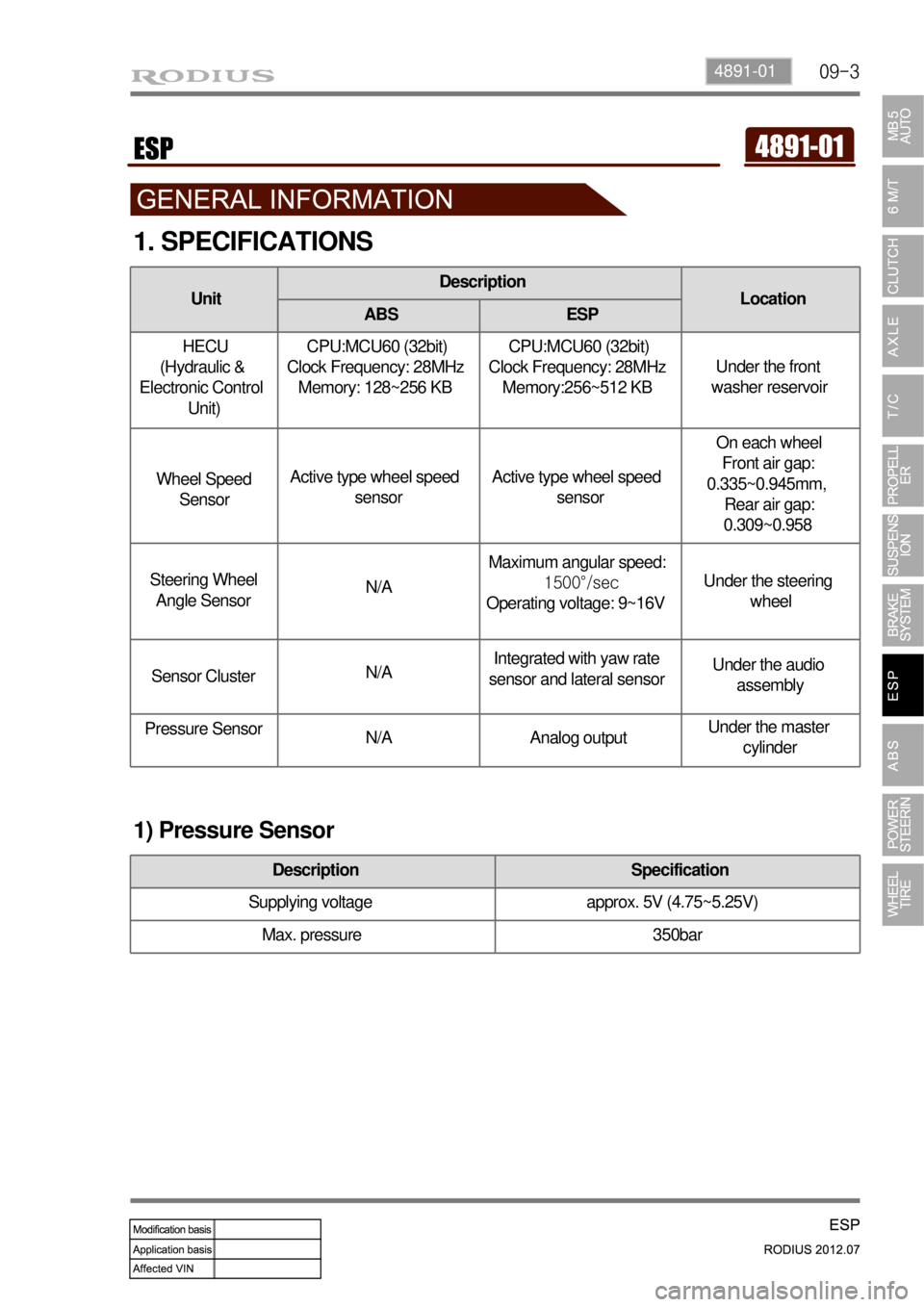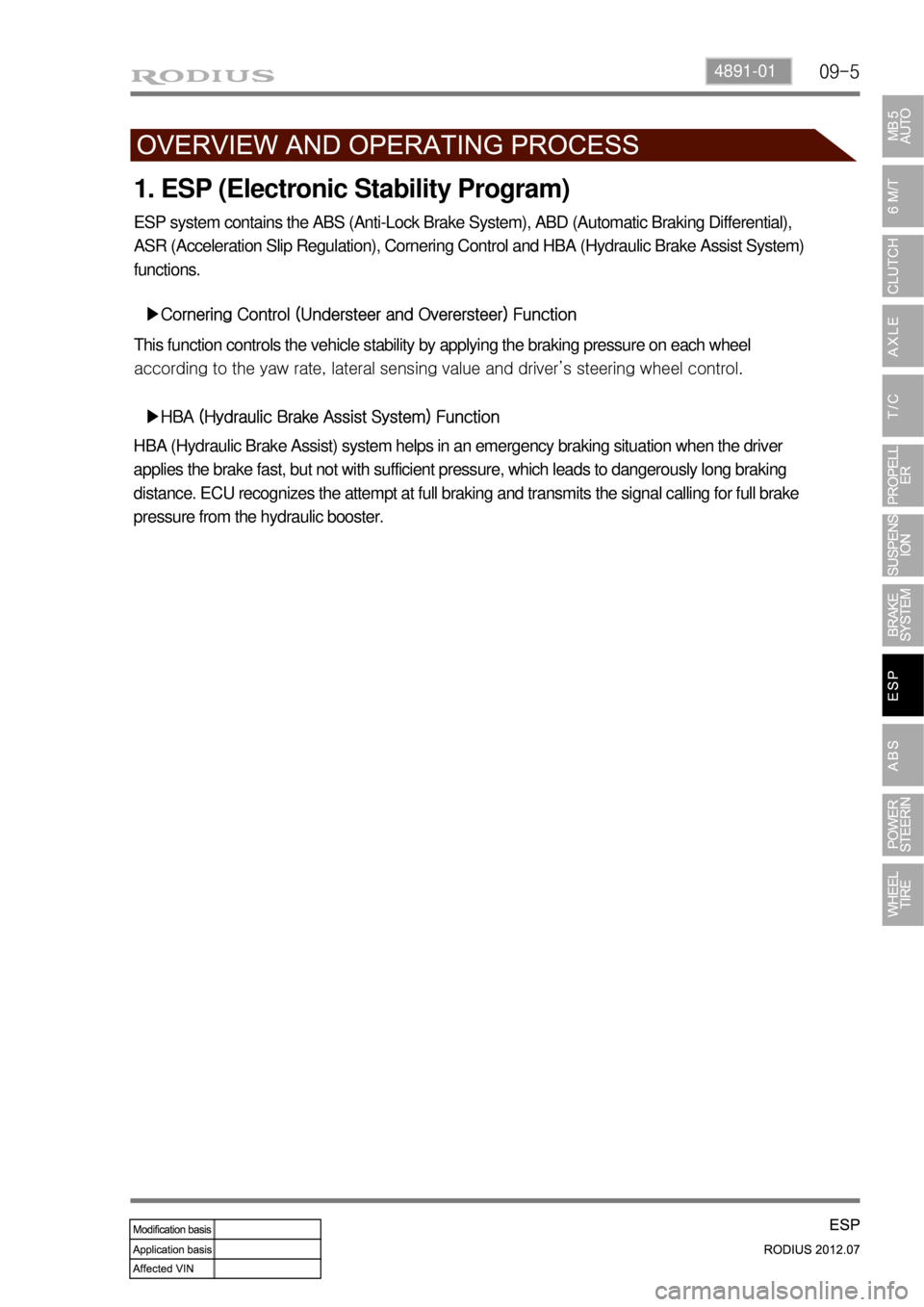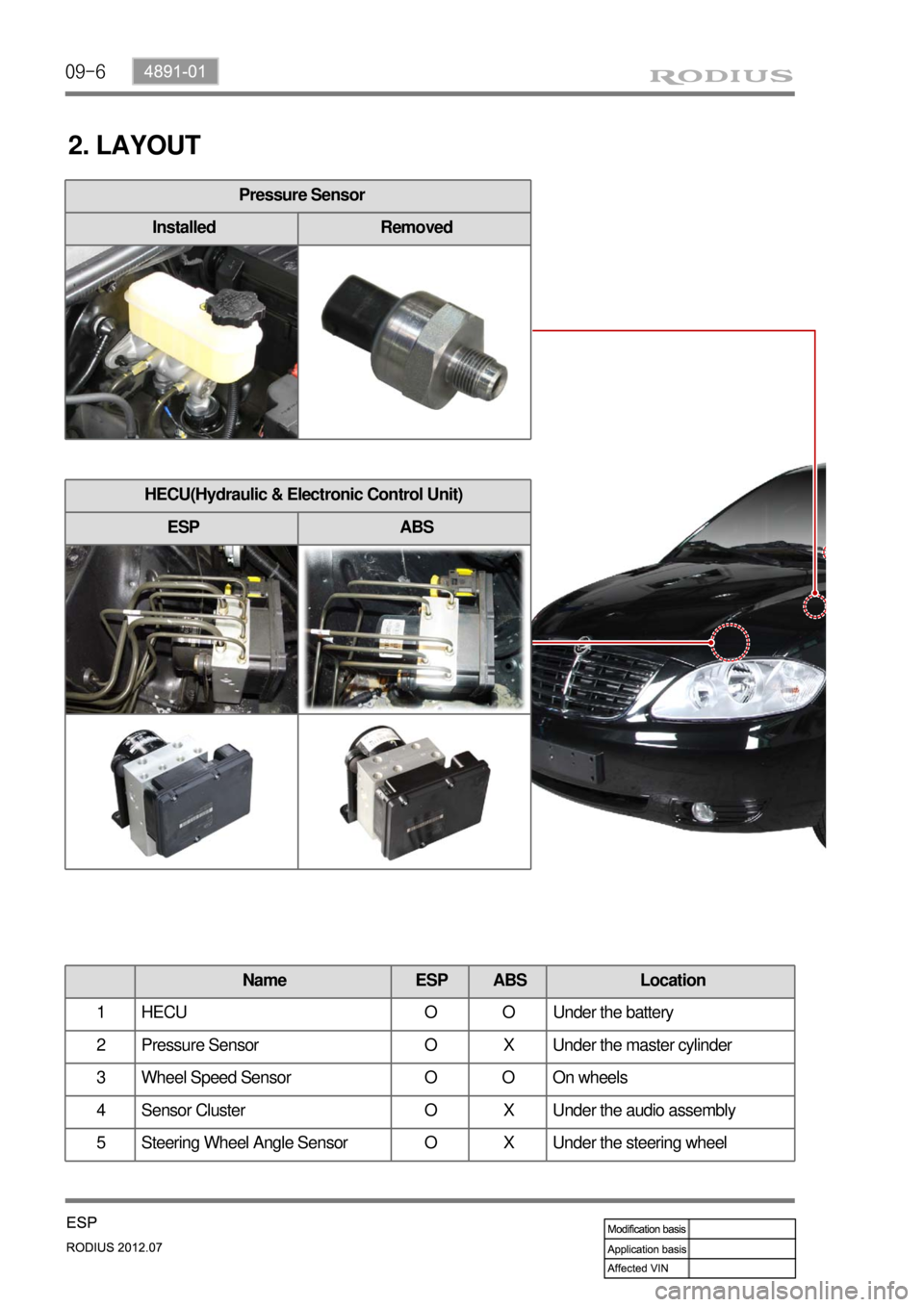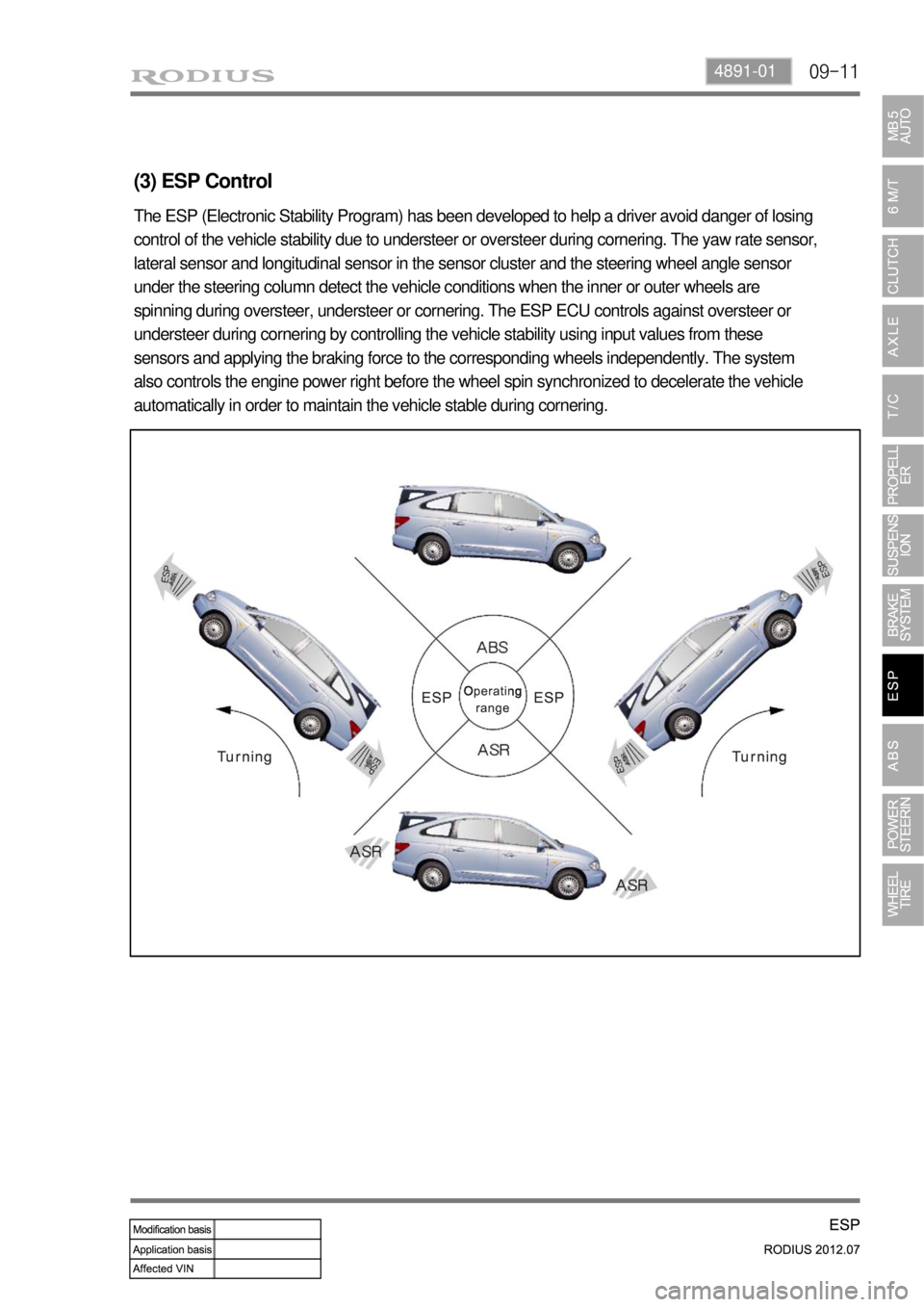ECU SSANGYONG RODIUS 2012 Workshop Manual
[x] Cancel search | Manufacturer: SSANGYONG, Model Year: 2012, Model line: RODIUS, Model: SSANGYONG RODIUS 2012Pages: 715, PDF Size: 79.36 MB
Page 476 of 715

03-37010-06
REKES Key
Immobilizer Unit
Diagnostic Connector
1. SYSTEM LAYOUT
1) Location
Immobilizer Warning Lamp
ECU
Page 477 of 715

03-4
2) System Diagram
The certification for the immobilizer is performed when turning the ignition switch to the "ON"
position after the CAN communication between the ECU and immobilizer is established.
Page 478 of 715

03-57010-06
2. OVERVIEW
The Immobilizer System provides an additional theft deterrent to the vehicle in which it is installed
and prevents it from being started by unauthorized persons. The transponder integrated in the key
and the engine control unit have the same code. When the ignition key with the integrated
transponder is turned to the ON position, the ECU (Engine Control Unit) checks the crypto code
of the key and, if correct, allows the vehicle to start the engine. If the verification has been failed,
the engine cannot be started and the immobilizer warning lamp blinks.
Immobilizer unit
Page 479 of 715

03-6
Transponder
3. VERIFICATION OF KEY
1) Verification
The immobilizer system prevents the vehicle theft by allowing only the authorized key to start the
engine. The transponder inside the key communicates with the immobilizer installed in the key
box, and the system permits the engine to start after confirming the encrypted coding from the
engine ECU.
In the following cases, a driver may be unable to start the vehicle with the immobilizer.The immobilizer unit transmits
the encrypted code to the
transponder. (2)
The transponder sends an encrypted signal to the unit as a response.
The transmitted code is changed to an encrypted signal in the unit.
The system compares the signal from transponder and the encrypted signal in immobilizer unit. (3)
(4)
(5)
When two or more immobilizer keys come into contact with (each) other(s).
When the key is close to any device sending or receiving electromagnetic fields or waves.
When the key is close to any electronic or electric devices such as lightening equipment,
security keys or security cards.
When the key is close to a magnetic or metal object or a battery. -
-
-
-
Immobilizer Unit
Page 480 of 715

03-77010-06
ECU
Immobilizer Indicator and Warning Lamp â–¶
This indicator comes on when the ignition
key is communicating with the engine
control unit (during engine starting) and
goes out after starting the engine.
When turning the ignition key to ON
position, the ECU transmits the challenge
message to the immobilizer unit to verify
whether the key is valid. (1)
Only when the two signals are identical, it
recognizes the key as the authorized one and
transmits the positive message to the ECU.
The ECU allows the engine to be started. (6)
(7)
Do not drop or shock to the transponder in the key as it may be damaged.
With a damaged transponder, the engine cannot be started.
When you erase the code or register an extra key, let the owner attend on the site.
In any case, the immobilizer system cannot be removed from the vehicle. If you attempt to
remove it and damage the system, starting will be impossible, so never attempt to remove,
damage or modify it.
The remote engine starter cannot be installed on the vehicle equipped with the immobilizer
system. -
-
-
-
-Lamp ON: in communication
Blinking twice for one second: immobilize
r
system failure
Blinking once for two seconds: immobiliz
e
unit is not coded
The immobilizer indicator does not
come on if the communication time
between immobilizer key and ECU is
too short.
Immobilizer Indicator and Warning Lamp
Page 492 of 715

07-4
2. CAUTIONS ON RAIN SENSOR
When the wiper switch is in the AUTO position, the wiper will operate for 1 cycle if the initial
engine start is made. This may cause the wiper blades to wear prematurely. Therefore, other
than rainy days, set the switch to the OFF position. Especially during the winter time, check if
the wiper blades are not frozen to the windshield.
Operating the wiper with the blades frozen can damage the wiper motor.
If you operate the wipers when the windshield is dry without spraying washer fluid, the
windshield can be scratched and the wiper blades can wear prematurely. Use the wiper with the
washer fluid when the windshield is dry.
When it does not rain, turn the wiper switch to the OFF position.
Turn the wiper switch to the OFF position before any car wash to avoid unwanted operation of
the wipers. -
-
-
-
When cleaning the windshield over the sensor with damp clothes, the wiper may operate
suddenly. It could cause serious injury. Make sure to place the wiper switch to the OFF
position and ignition switch OFF when not in use.
Irregular operation (abrupt operation) â–¶
Check if the sensor is off the position.
Check if the rain sensor cover is securely installed.
Check if the customer is familiar to how to control the wiper sensitivity.
Check if the wiper sensitivity control is set to the FAST side (step 5).
Check the wiper blade for wear.
If the wiper blade cannot wipe the glass uniformly and clearly, it may cause the rain sensor to
work irregularly. Therefore, in this case, replace the wiper blade with a new one. -
-
-
-
Page 611 of 715

09-34891-01
1. SPECIFICATIONS
1) Pressure Sensor
UnitDescription
Location
ABS ESP
HECU
(Hydraulic &
Electronic Control
Unit) CPU:MCU60 (32bit)
Clock Frequency: 28MHz
Memory: 128~256 KB CPU:MCU60 (32bit)
Clock Frequency: 28MHz
Memory:256~512 KB Under the front
washer reservoir
Wheel Speed
SensorActive type wheel speed
sensorActive type wheel speed
sensorOn each wheel
Front air gap:
0.335~0.945mm,
Rear air gap:
0.309~0.958
Steering Wheel
Angle SensorN/AMaximum angular speed:
1500°/sec
Operating voltage: 9~16VUnder the steering
wheel
Sensor ClusterN/AIntegrated with yaw rate
sensor and lateral sensorUnder the audio
assembly
Pressure Sensor
N/A Analog outputUnder the master
cylinder
Description Specification
Supplying voltage approx. 5V (4.75~5.25V)
Max. pressure 350bar
Page 613 of 715

09-54891-01
1. ESP (Electronic Stability Program)
ESP system contains the ABS (Anti-Lock Brake System), ABD (Automatic Braking Differential),
ASR (Acceleration Slip Regulation), Cornering Control and HBA (Hydraulic Brake Assist System)
functions.
â–¶Cornering Control (Understeer and Overersteer) Function
This function controls the vehicle stability by applying the braking pressure on each wheel
according to the yaw rate, lateral sensing value and driver’s steering wheel control.
â–¶HBA (Hydraulic Brake Assist System) Function
HBA (Hydraulic Brake Assist) system helps in an emergency braking situation when the driver
applies the brake fast, but not with sufficient pressure, which leads to dangerously long braking
distance. ECU recognizes the attempt at full braking and transmits the signal calling for full brake
pressure from the hydraulic booster.
Page 614 of 715

09-6
HECU(Hydraulic & Electronic Control Unit)
ESP ABS
2. LAYOUT
Name ESP ABS Location
1 HECU O O Under the battery
2 Pressure Sensor O X Under the master cylinder
3 Wheel Speed Sensor O O On wheels
4 Sensor Cluster O X Under the audio assembly
5 Steering Wheel Angle Sensor O X Under the steering wheel
Pressure Sensor
Installed Removed
Page 619 of 715

09-114891-01
(3) ESP Control
The ESP (Electronic Stability Program) has been developed to help a driver avoid danger of losing
control of the vehicle stability due to understeer or oversteer during cornering. The yaw rate sensor,
lateral sensor and longitudinal sensor in the sensor cluster and the steering wheel angle sensor
under the steering column detect the vehicle conditions when the inner or outer wheels are
spinning during oversteer, understeer or cornering. The ESP ECU controls against oversteer or
understeer during cornering by controlling the vehicle stability using input values from these
sensors and applying the braking force to the corresponding wheels independently. The system
also controls the engine power right before the wheel spin synchronized to decelerate the vehicle
automatically in order to maintain the vehicle stable during cornering.